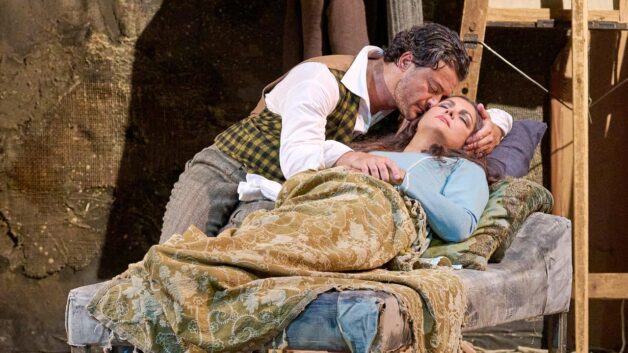 Austria Puccini, La bohème: Soloists, Chorus and Orchestra of Vienna State Opera / Bertrand de Billy (conductor). Recorded (directed by Jakob Pitzer) at Vienna State Opera on 11.9.2022 and streamed on 14.2.2023. (JPr)
Austria Puccini, La bohème: Soloists, Chorus and Orchestra of Vienna State Opera / Bertrand de Billy (conductor). Recorded (directed by Jakob Pitzer) at Vienna State Opera on 11.9.2022 and streamed on 14.2.2023. (JPr)

Production:
Production and Stage design – Franco Zeffirelli
Costume design – Marcel Escoffier
Chorus – Martin Schebesta
Cast:
Rodolfo – Vittorio Grigolo
Mimì – Anna Netrebko
Marcello – George Petean
Schaunard – Martin Hässler
Colline – Günther Groissböck
Musetta – Nina Minasyan
Benoît / Alcindoro – Marcus Pelz
Parpignol – Martin Müller
Sergeant of the Customs Guard – Wataru Sano
When a planned production of La Juive was cancelled earlier this season due to illness with its announced leading singers it was replaced by the Vienna State Opera’s venerable La bohème production. Some of the cast of the Halévy opera were retained in the smaller roles with Vittorio Grigolo and Anna Netrebko parachuted in as Rodolfo and Mimì. For various reasons in many opera houses around the world they are personae non gratae but are generally welcomed in Vienna.
Franco Zeffirelli’s La bohème premiered in November 1963, and this was a recording of its 450th performance on 11th September 2022! On one of my visits to Vienna around 40 years ago I saw this production and from all the close-up camerawork it looked like the sets, furnishings and some of Marcel Escoffier’s costumes (if they weren’t the artists’ own) hadn’t been cleaned since I saw them then. Of course, a certain shabbiness could only add to the cinema-style realism of Zeffirelli’s familiarly uber-traditional and unashamedly romantic staging. There wouldn’t have been a lot of rehearsal time, yet a strong cast of singing-actors meant that we got a real slice of bohemian life in Zeffirelli’s faithful recreation of nineteenth-century Paris. The rather large Latin Quarter attic is rather dusty and dirty; in the director’s typical fashion the streets on two levels outside the Café Momus are excessively overcrowded (and to be honest it was distinctly under-rehearsed here) and the snowy Barrier d’Enfer rather too dark after six decades.
However, what we still saw at the heart of this La bohème was its essential emotional truth and joie de vivre from a very mature-looking quartet of penniless – but aspiring – artists; Rodolfo and Marcello’s love interests, Mimì and Musetta; and the enthusiastic Café Momus crowd (including some notably lively children). Sometimes new productions of Puccini’s opera can lack this.
This opera was the composer’s fourth for the stage and its Turin première was in 1896 and it is still amazing how it polarised the critics at the time. The source material for Puccini’s librettists, Luigi Illica and Giuseppe Giacosa, was Henry Murger’s novel Scènes de la vie de bohème and they selected four of the characteristic episodes and imbued them with the spirit of the original and although set in Paris about 1830, the story is a timeless one. Far too many people believe that what composers create is divorced from their personal life and the world in which they lived, but this was definitely not the case for Puccini. His masterpieces are often biographical in nature and in La bohème there is the reminiscence of Puccini’s own student days when he shared a room in Milan with Mascagni. In fact, his graduation exercise from the Milan Conservatoire, Capriccio sinfonico, is the first music we hear as the curtain rises for La bohème.
Certain elements of Puccini’s musical style help to confirm the opera as the ‘masterpiece’ it undoubtedly is. He appears more open to the concept of symphonic development than other Italian opera composers, Verdi especially. Based on this, Act II has been considered the ‘scherzo’ and Act III the ‘slow movement’ and there is a greater sense of La bohème – as with his other operas – being ‘through-composed’ just as in some symphonies.
Günther Groissböck was luxury casting as the bookish Colline and he brought all the assurance of his resonant bass voice to ‘Vecchia zimarra, senti’ – his character’s peculiar Act IV farewell to his coat – which was as poignant and heartfelt as I can ever remember. George Petean didn’t have the suavity of some of the finest Marcellos, but he still sang sonorously and acted vividly, whilst Martin Hässler’s robustly sung Schaunard was more stoic than some in this role. Meanwhile Markus Pelz had great fun with his comic vignettes as the lascivious Benoît and a deceived Alcindoro.
Nina Minasyan was a pert, charismatic Musetta who, though undoubtedly flighty and a gold-digger, proves at the end that she has a heart of gold. As Rodolfo, Vittorio Grigolo had some of the eager puppy-dog exuberance of Rolando Villazón at the height of his career and was a believably infatuated Rodolfo. Grigolo’s voice still has the ringing quality and effortless top notes a great Rodolfo needs.

Anna Netrebko was not the most consumptive of Mimìs but sounded – admittedly through loudspeakers – at her very best bringing open lyricism and an impeccably controlled and richly coloured soprano voice to a role which she acted with dramatic credibility. There was great chemistry throughout with Grigolo’s Rodolfo and as Mimì’s demise drew closer they brought heart-wrenching tenderness to ‘Addio, dolce svegliare’ in the final act.
The propulsive baton of Bertrand de Billy drew some elegant playing from the Vienna State Opera Orchestra, would you expect anything less? There was exceptionally lustrous strings, bright brass, and sweet-toned woodwind. Several – often opaque – musical details seemed to be revealed and there were a number of truly memorable musical moments.
Jim Pritchard
